
About my art destruction activities
When I was 6 years old
We heated the house with coal
Two chimney-sweeps came
To clear our chimney
One climbed on the roof
The other came into the room
Where I was looking
He put the stove aside
And spoke through the chimney
To his companion
I heard the voice
of the man on the roof
coming out of the pipe
Then the man in the room
Held a big bag before the pipe
And at once
A big mass of black powder
Came down.
The voice from above
Now sounded from the bag
But much less clear
I believed the man
When he said that
he caught him into the bag
Then he took
The powder on his back
And walked away
I felt that I stepped
into a dangerous field
but the transformation
of all kind of paper
and contents
was a strong obsession now
Every gift was
like
a serious joke

I attacked my brother
and
other children,
who were drawing
faces in suns
The souls of the drawings
came out of the remains
and transformed themselves
onto the wall

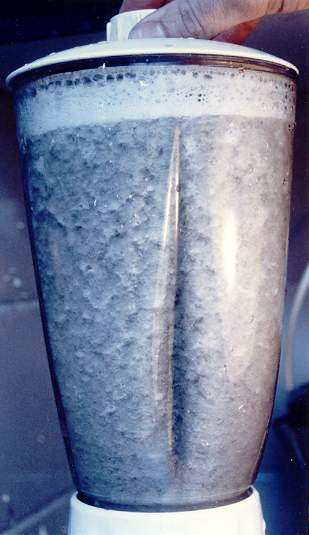
In 1986 I was writing my thesis for my studies in Art History, about the Russian artist and architect El Lissitzky.
In order to loose the tension I went to the kitchen and I put old newspapers in a blender that I used before to make ink from oak-galls.
Vaguely I had in mind to make paper, but I never came further than the stadium of making pulp.
I used lots of warm water to grind and pulverise the paper.
I liked the warm, soft and moist substance of the pulp.
Gifts
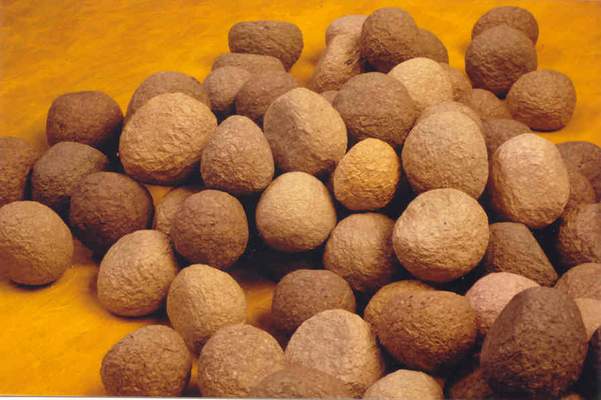
In order to preserve the pulp I made balls out of it, pressed the water out and let the balls dry on the ground. I liked to destroy in this way old newspapers. There was a feeling that in erasing the enormous amount of information there was something nice, delightful, pleasant, satisfying. I also felt that there was a kind of obsession in me for that destruction. I thought it was very human. Destructive feelings in man might be as strong as constructive. I did not mean to do something with the pulp which I would call "art" or so.
I added strong colours to the pulp, I put the pulp in a jar and I put a label on it, telling that it were, for example, mixed articles about Vincent Van Gogh, and I gave it to a friend who loved Van Gogh. Thus the visible aspect became important: adding of colours like red, blue, yellow, or rose. Every gift was like a serious joke. The presents were faking articles, which could not be read.
Railway Guide
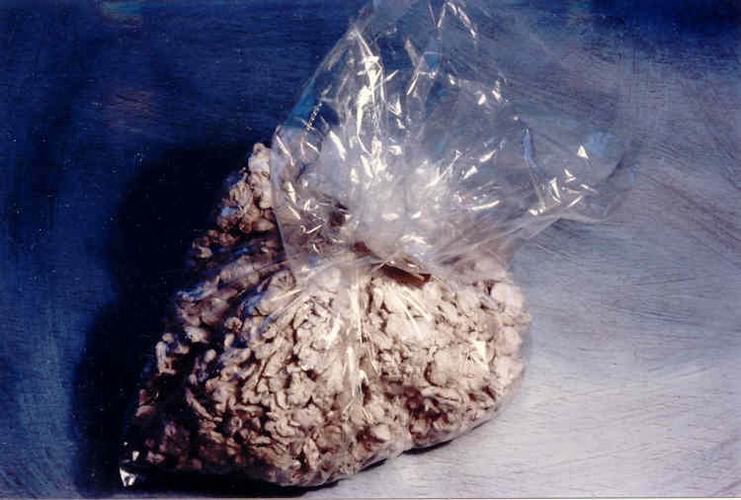
In a later phase I started to destroy certain papers or books as a whole. In this phase the destruction became a stronger obsession. I kept the leftovers as leftovers of what they had been before. In this way I was more sincere, I did not lie about what it was. I destroyed advertising leaflets, boxes, all kinds of guide-books and a telephone guide. In the plastic bag on the photo you see the leftovers of a railway-guide of about 500 pages. The contents looked like ashes, but at the same time I could see them as seeds.
After the destruction of those rather ordinary texts I took the Bhagavad-Gita. This book is dealing itself with destruction. I felt that I stepped into a dangerous field, but the transformation of all kind of paper and contents was a strong obsession now.
Postcodebook
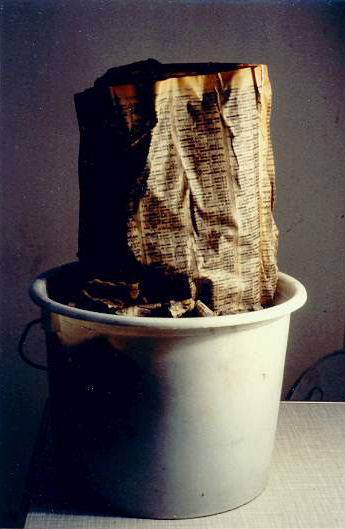
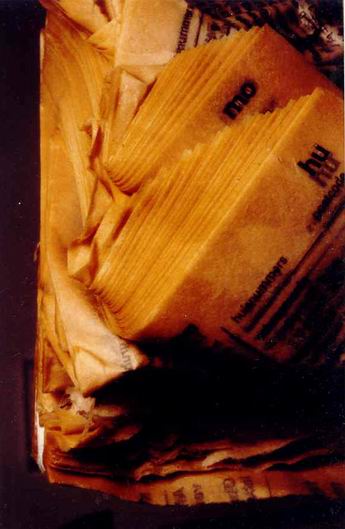
I made a series of photos of the process of transforming the Dutch postcodebook: making the book wet, torning the pages out, putting them into the mixer, turning the mixer on, and off again, putting the pulp in a spin-drier, scraping the pulp out of the spin-drier, laying the pulp on the ground to dry it.
Genesis of 1000 destroyed drawings

The urge to colour the pulp with pigments seemed betraying. Then I realized that I had a large quantity of paper, to which I did not have to add any colours. They were ready made with pigments of all kinds. I had about 3000 drawings and prints in store, mostly dating from the time I was in the academy.
I did not know what to do with them. There were many models and portraits and all kinds of figurative and abstract studies. Only a few I exhibited on different occasions. But in fact for long I had stopped painting, while I was studying Art History. Now I thought about consuming all my works for my obsession to destroy. I imagined how it would look like to see them all in jars. I thought it would be an interesting image. The image of destruction.
And there were more associations. To destroy a drawing in the way I wanted to do means to mix the thin layer of the image with the paper. Many people see a painting as a thing that is almost alive. Museums are visited like places of religious worship. Paintings serve as some kind of golden lambs. I also love to visit museums and I did not think about destruction of someone else's paintings. But I thought I could use my own works for my obsession and to kill them by means of grinding them in the blender.
Now I really thought about making an exhibition of the drawings, transformed into pulp. I made a single try, by making a quick drawing and putting it in the blender immediately. I wrote about it for myself, and I noted all the associations I had, but I did not publish it, nor did I tell anybody about my plan. I was very much afraid for a possible negative, critical, angry, rude, despising or cynical reaction, as I had experienced before when I had a plan that was a little bit different then what was normal. I felt a very strong fear.
Other destroying artists
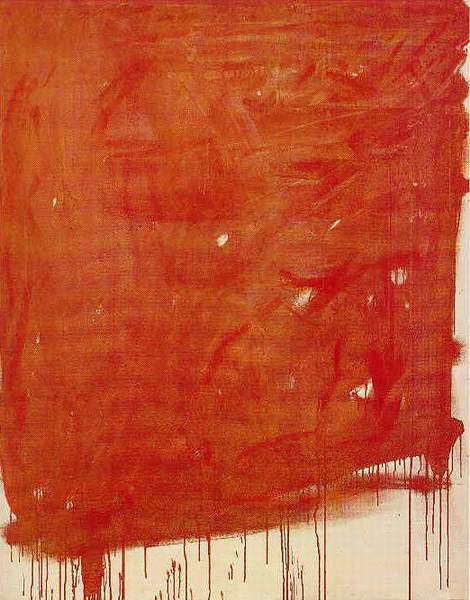
Arnulf Rainer
Braune Ubermalung, 1957
Oil on board, 107x86 cm
Private Collection
As I saw before that everything that can be done is already done I started to look for an artist that had already done the same or something similar. I knew that the Austrian artist Arnulf Rainer had overpainted his own work. He took a painting of his and painted it with an almost black colour, until only a very small part in a corner was left. He also was dealing with death: He took photos of death masks and made lines and scratches on them, thus altering the image.

Denmark
Dood archief XVI, 1974-1984
Braakpoeder, 75 bottles with magazine powder 222x120 cm
Detail
I found out that the Belgian artist DenMark had made blocks of one year of newspapers, transformed them into powder and exhibited them in bottles. When I saw these bottles with the grayish powder I thought that I did better not destroy my drawings, and not exhibit them, because they looked too much the same.
I also found a painter from the seventeenth century who was only painting jars with bottled fruits. And recently I heard that there was an artist who made cookies out of his old oilpaintings and turned to conceptual art. I was too shy and stopped the project.
Texts
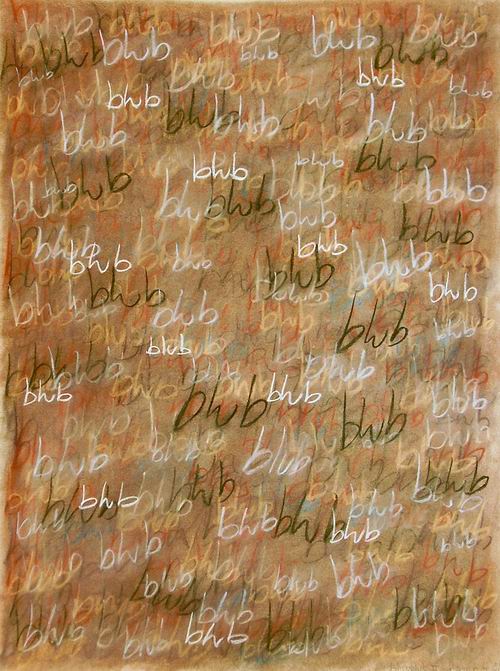
Around 1981 I myself had done something similar, when I was writing words on sheets of paper, erasing them and writing them anew. I exhibited them on several occasions.
The actual destruction work
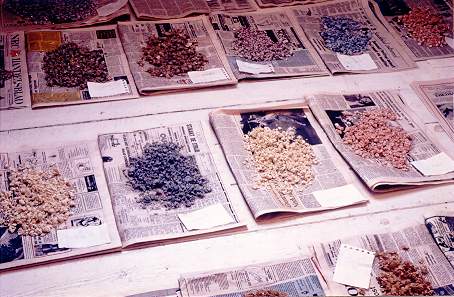
Only after receiving my masters degree in Art History I realized that one of the reasons for me to destroy my old drawings was that the transformation of them into grey seed-like grains might not only result in an interesting image, but also give me an impulse for starting to work again. I was at a point that many people have "What shall I create" and I realized that I did not really want to create. So the obsession with destruction won and I decided to carry out the plan. At once I felt very sure that at least for myself it might be a healthy job.
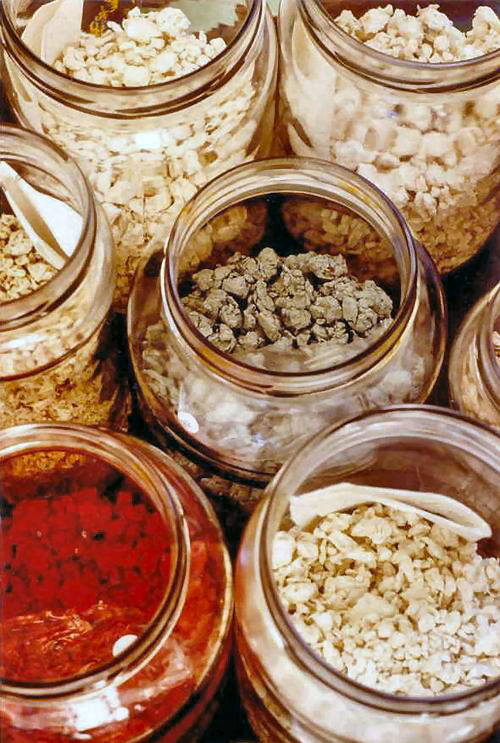
I managed to convince a curator to give me an exhibition and I even managed to get a grant for the costs. I started in the beginning of 1989. Before the destruction, I made an archive of all works, so that the descriptions, titles, years, materials and dimensions were kept. I made a scheme and ground everyday a certain amount of drawings. Small ones in 1 time, big ones (70x100 on heavy paper) in 4 times. Soon my house was all over full of drying heaps of drawings. Each heap has a note with a number. I took great care that the notes wouldn't mix. But once I was angry and I slammed the door. Many parts of one drawing were blown into another heap and I was busy for hours in order to order the mess. Happily one was almost white, the other black.
I asked many people to help me to collect jars. But half of the 1000 I had to buy. I got them from a factory of biological peanut-butter, which used the ideal jar.
Most destroyed drawings had a smooth structure, but some had an image that was too strong too destroy totally. Paper and material were sometimes not totally mixed. The leftovers are visible as small points in the pulp.
The Exhibition
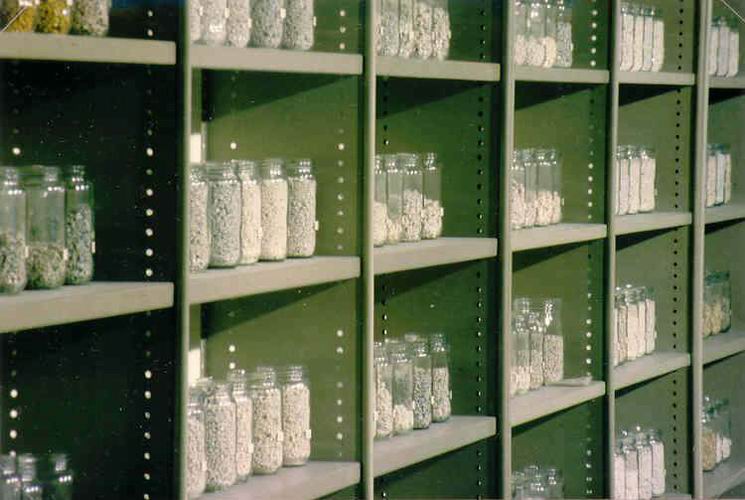
At the exhibition 1000 jars were standing at 140 shelves in 20 Cabinets. On the floor there was a list of all the works with titles, descriptions, years, materials and dimensions. For instance "374/F129 A model is leaning with her elbow on a stick and with her chin on her hand, 1978-79, charcoal on paper 100 x 75 cm, grained February 15 1989". Grey colours dominate, but they are all different. The shade of grey depended on the paper and the amount and sort of pigments. Here and there grains have a clear colour.
Drawings of destroyed drawings
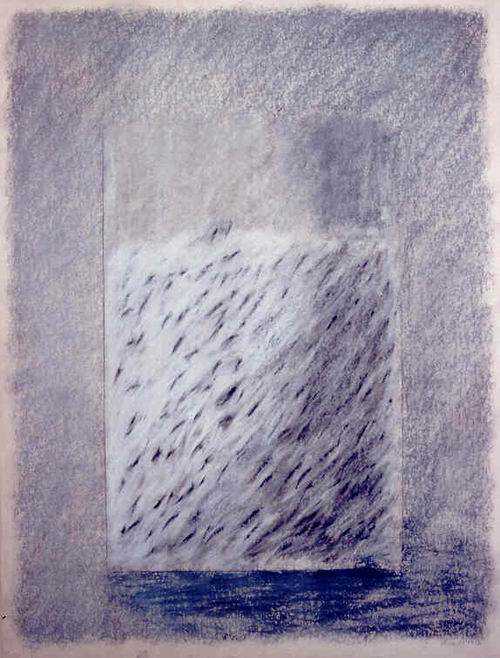
After I had finished the destruction I started to make drawings of the jars with destroyed drawings. It seemed to me the only thing to create. First I made sketches, made from free hand. Then I turned into cross-sections.
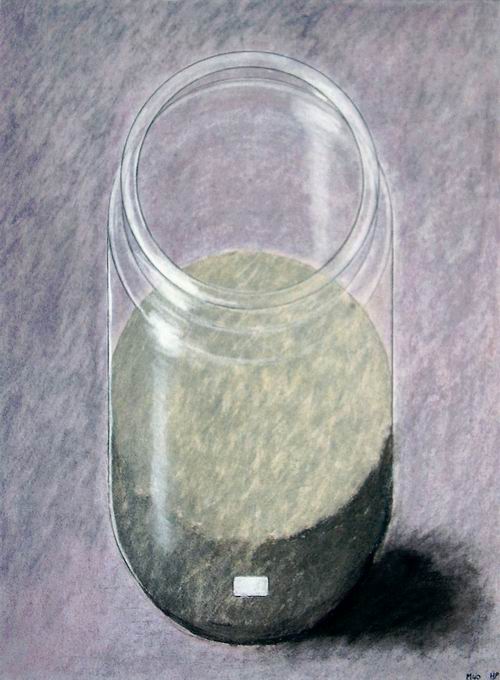
Later I made axonometries, using compass and ruler. An axonometry shows the top
of the jar and of the contents as it is, a circle, and the side as it is, with
the sticker. Above and side are thus visible in one time.
Some of these drawings were together with the destroyed drawings on the
exhibition. The glass of their frames was mirroring the jars.
Sun jar

In those first drawings circles appeared many times. In one of the drawings the
light circle was a little bit yellowish. I remembered that, when I was a little
boy, it was very important for me to add to any drawing a yellow sun. The colour
yellow is warm and made every drawing warm. My opinion as a little child was,
that the sun should not have a face. I disliked the faces that were drawn on
suns and moons in children books. I attacked my brother and other children,
drawing faces in suns. I told them that the real sun had no face. Thus in fact I
was very realistic.
Already before I felt the urge to do something with a yellow circle representing
a sun. Now I transformed the top of the contents into a sun. A sun in a jar as
if the jar was a universe. The sun is the spring of all life on earth. At the
same time the jar with sun seemed to me to be a microscopic cell. I started to
make all kinds of variations. Soon there were two standard jars: one with
converging sides, and one with parallel sides.
Destroyed drawings transformed onto the wall
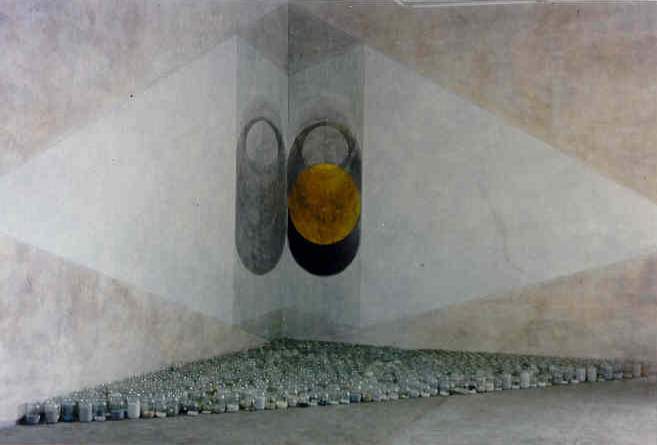
When I found a possibility to exhibit my sun jars, I went to look at the space.
I took a little booklet, in which I had drawn some of the standard forms of sun
jars. I imagined the jars on the wall. When I held these middle pages against a
corner I imagined them, painted on the two walls. The other artists agreed to
let me paint this part of the space.
I worked a whole week painting this construction. I designed the construction at
home. I made a slide and projected it first straight on the right wall and then
tilted on the left wall. It was about three and a half meters high and two times
six meters long. I used wet towels with acrylic paints two fill in the forms.
Two jars are hanging in a construction. The jars seemed to change while walking
through the room from wide to narrow.
I decided to put the real jars in triangle at the floor. The souls of the
drawings came out of the remains and transformed themselves onto the wall.


